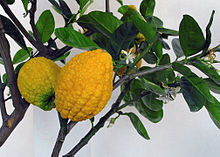C. medica
| Citron Citrus medica |
|
|---|---|
 |
|
| Scientific classification | |
| Kingdom: | Plantae |
| (unranked): | Angiosperms |
| (unranked): | Eudicots |
| (unranked): | Rosids |
| Order: | Sapindales |
| Family: | Rutaceae |
| Genus: | Citrus |
| Species: | C. medica |
| Binomial name | |
|
Citrus medica L. |
|
The citron is a large fragrant citrus fruit with a thick rind, botanically classified as Citrus medica by both the Swingle and Tanaka botanical name systems. It is one of the four original citrus fruits (the others being pomelo, mandarin and papeda), from which all other citrus types developed through natural hybrid speciation or artificial hybridization.
The fruit's English name "citron" derives ultimately from Latin, citrus, which is also the origin of the genus name.
A source of confusion is that or similar words in French, Lithuanian, Hungarian, Finnish, Latvian, the West Slavic languages, and all Germanic languages but English are false friends, as they refer to the lemon. Indeed, into the 16th century, the English name citron included the lemon and perhaps the lime as well. In Italian it is known as a cedro.
In Persian languages, it is called Turunj, as against "Naranj" (bitter orange); both names borrowed by Arabic and introduced into Spain and Portugal after their occupation by the Muslims in AD 711, whence it became the source of the name orange. In Syria it is called Kabbad; in Japanese it is called Bushukan (maybe referring only to the fingered varieties).
...
Wikipedia
